Choosing the right kitchen flooring can transform your space. It plays a vital role in the overall design and functionality.
Your kitchen is the heart of your home. It’s where meals are prepared, and families gather. The flooring you choose needs to withstand spills, heavy foot traffic, and daily wear. With so many options available, finding the perfect one can be overwhelming.
Whether you prefer the warmth of hardwood, the durability of tile, or the affordability of vinyl, each flooring type offers unique benefits. This guide will help you understand the best flooring options for kitchen interior design. We’ll explore different materials, styles, and features to help you make an informed choice. Get ready to discover the ideal flooring to complement your kitchen interior design.
Tile Flooring
Tile flooring is a popular choice for kitchen interiors. It offers durability and aesthetic appeal. Two common types of tile flooring are ceramic tiles and porcelain tiles. Each has unique benefits and characteristics. Let’s explore these options.
Ceramic Tiles
Ceramic tiles are made from clay and other natural materials. They are fired in a kiln, making them hard and durable. Ceramic tiles come in various colors, sizes, and patterns. This variety allows you to match any kitchen design. They are also easy to clean. Spills and stains can be wiped away with ease.
Another advantage of ceramic tiles is their affordability. They are cost-effective, making them accessible for many homeowners. These tiles are also resistant to moisture, which is important in a kitchen setting. However, they can be prone to chipping if heavy objects fall on them. Regular maintenance can help prevent damage.
Porcelain Tiles
Porcelain tiles are a type of ceramic tile. They are made from finer, denser clay and fired at higher temperatures. This process makes them more durable and less porous than regular ceramic tiles. Porcelain tiles are ideal for high-traffic areas like kitchens. They can withstand heavy use and resist wear and tear.
Porcelain tiles often mimic the look of natural stone, wood, or other materials. This versatility allows you to achieve various styles without the cost of natural materials. They are also resistant to water and stains, making them easy to maintain. While porcelain tiles can be more expensive, their longevity and low maintenance make them a worthwhile investment.
You may like it: Different Types of Flooring Options for Interior Design
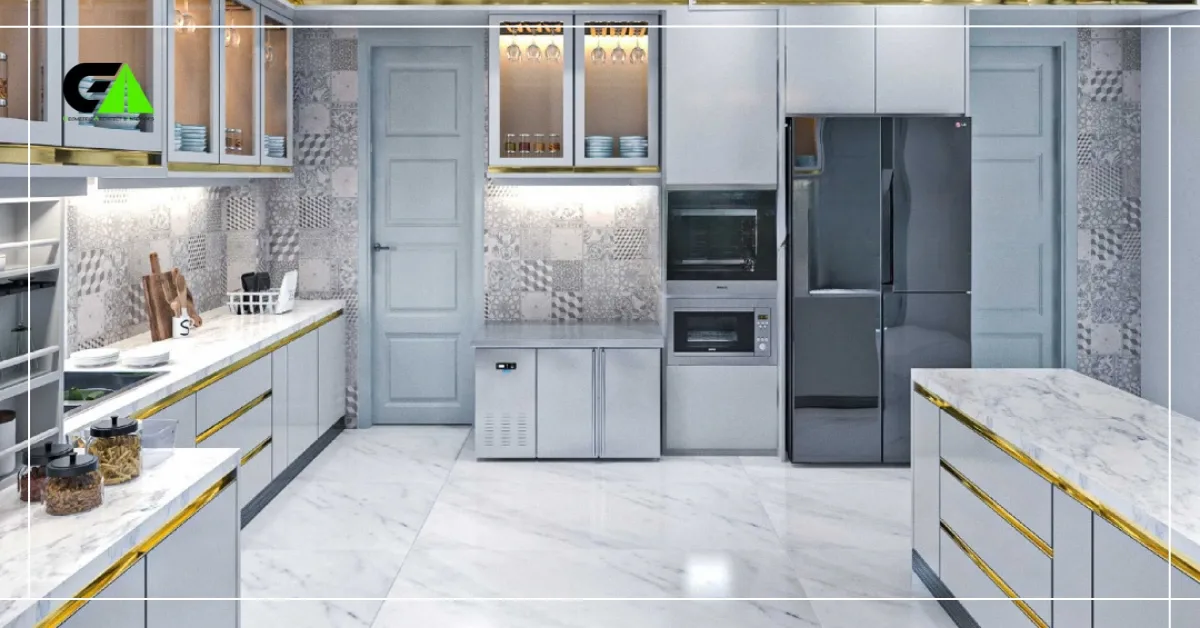
Hardwood Flooring
Choosing the right flooring for your kitchen is crucial. Hardwood flooring stands out for its timeless appeal and durability. This flooring type adds warmth and elegance to any kitchen space. Hardwood flooring comes in two main types: engineered wood and solid wood. Each has its own unique features and benefits.
Engineered Wood
Engineered wood offers a versatile and durable option for kitchen floors. It consists of multiple layers of wood bonded together. The top layer is real hardwood, giving it a natural look. The layers below are designed to add strength and stability.
- Engineered wood resists humidity changes better than solid wood.
- It can be installed over concrete or existing flooring.
- This type is less likely to warp or bow over time.
Engineered wood comes in various styles and finishes. It can mimic the look of more expensive hardwoods. This makes it a cost-effective choice for many homeowners. Maintenance is easy with regular sweeping and occasional mopping.
Solid Wood
Solid wood flooring is made from a single piece of wood. It offers a classic and authentic look. Solid wood is known for its longevity and can be refinished multiple times. This extends its life and keeps it looking new.
- Solid wood provides a higher resale value for your home.
- It offers a wide range of wood species, colors, and grain patterns.
- This type of flooring can be sanded and refinished to remove scratches.
Installing solid wood requires careful planning. It is best suited for kitchens with stable humidity levels. Regular maintenance includes sweeping and occasional refinishing to maintain its beauty.
Both engineered and solid wood flooring offer unique benefits. Choosing the right type depends on your kitchen’s needs and your personal preferences.
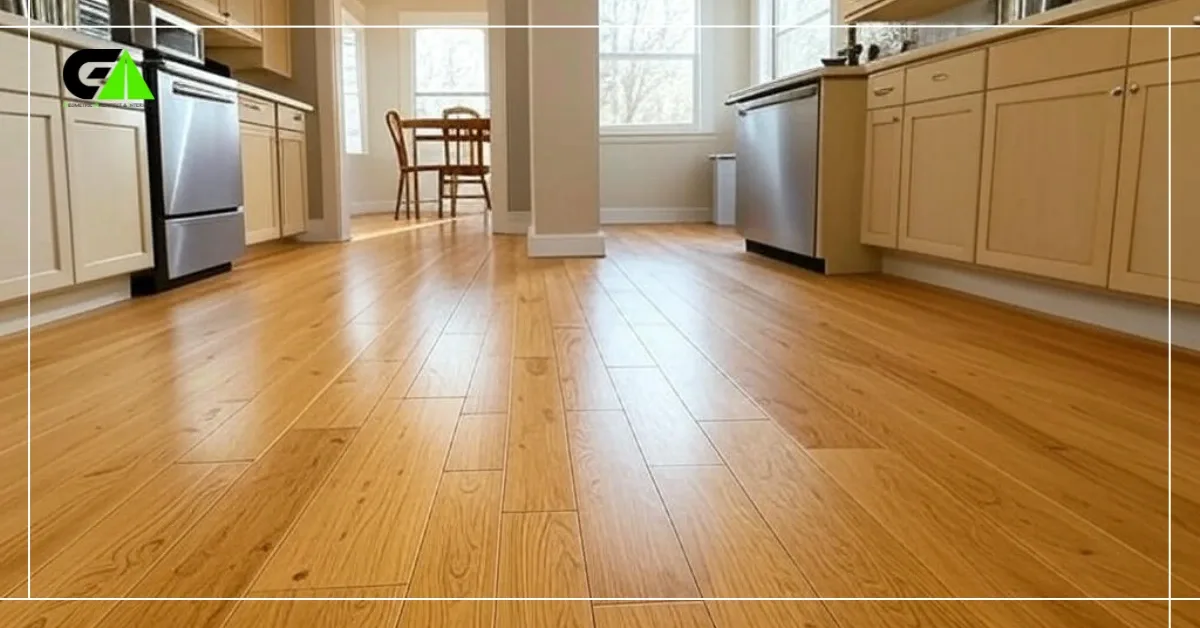
Vinyl Flooring
Vinyl flooring is a popular choice for kitchen interiors. It offers durability, water resistance, and a variety of styles. Easy to maintain, vinyl can mimic natural materials like wood and stone. This makes it a versatile option for any kitchen design.
Luxury Vinyl Plank
Luxury Vinyl Plank (LVP) is a top choice for its realistic look. It resembles hardwood but with added benefits. LVP is water-resistant, perfect for kitchen spills. It also provides a softer feel underfoot compared to tiles. Installing LVP is simple with click-and-lock systems. Its durability ensures it withstands heavy kitchen traffic. Choose from numerous colors and textures to match your decor.
Sheet Vinyl
Sheet vinyl is another excellent kitchen flooring option. It comes in large, continuous sheets, reducing seams. This feature makes it highly water-resistant. Sheet vinyl is also very affordable. It provides a cushioned feel, making it comfortable to stand on. Cleaning sheet vinyl is a breeze, requiring only a damp mop. With various patterns and colors available, it can suit any kitchen style.
You may like it: 10 Best Tips And Tricks For Small Kitchen Interior Design
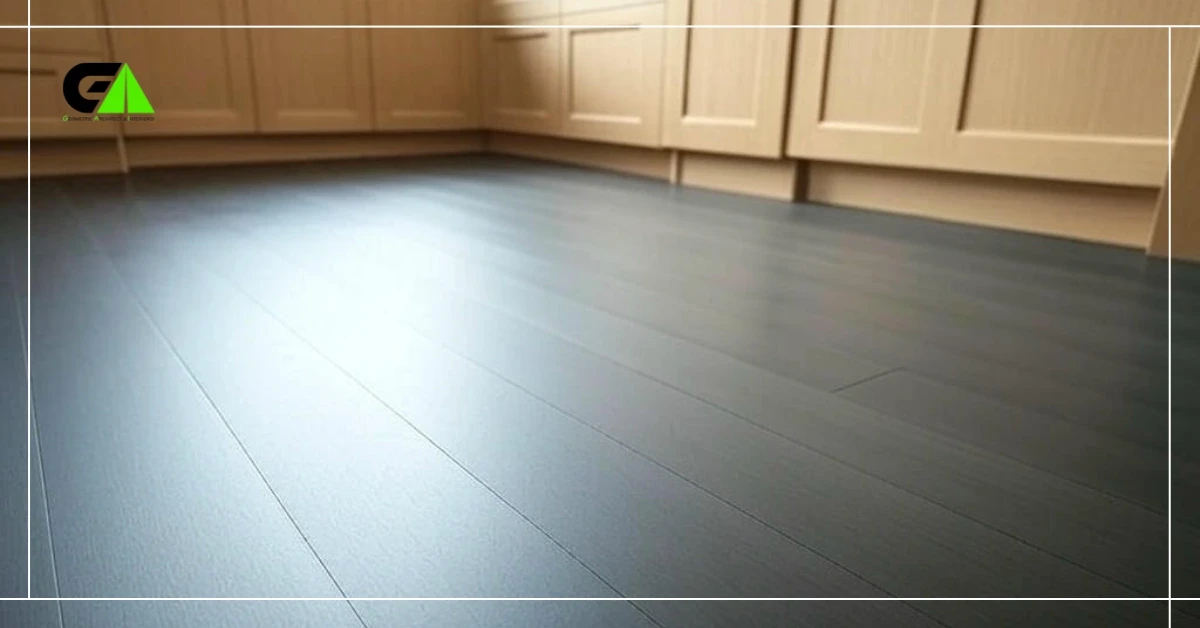
Laminate Flooring
Laminate flooring is a popular choice for kitchen interiors. It offers durability, style, and ease of maintenance. This flooring type mimics the look of wood or stone at a fraction of the cost. It’s an excellent option for homeowners wanting an affordable yet stylish solution for their kitchens.
Water-resistant Laminate
Water-resistant laminate is a great choice for kitchen floors. Kitchens often deal with spills and splashes. This type of laminate can handle moisture better than traditional laminate. It has a special coating that makes it more resistant to water. This feature helps prevent swelling and warping. So, it stays looking good for longer.
High-gloss Laminate
High-gloss laminate adds a touch of elegance to any kitchen. It has a shiny surface that reflects light, making the space feel brighter. This type of laminate is easy to clean. Dirt and spills wipe away with little effort. It’s also scratch-resistant, which keeps it looking new for years. High-gloss laminate is perfect for modern kitchen designs.
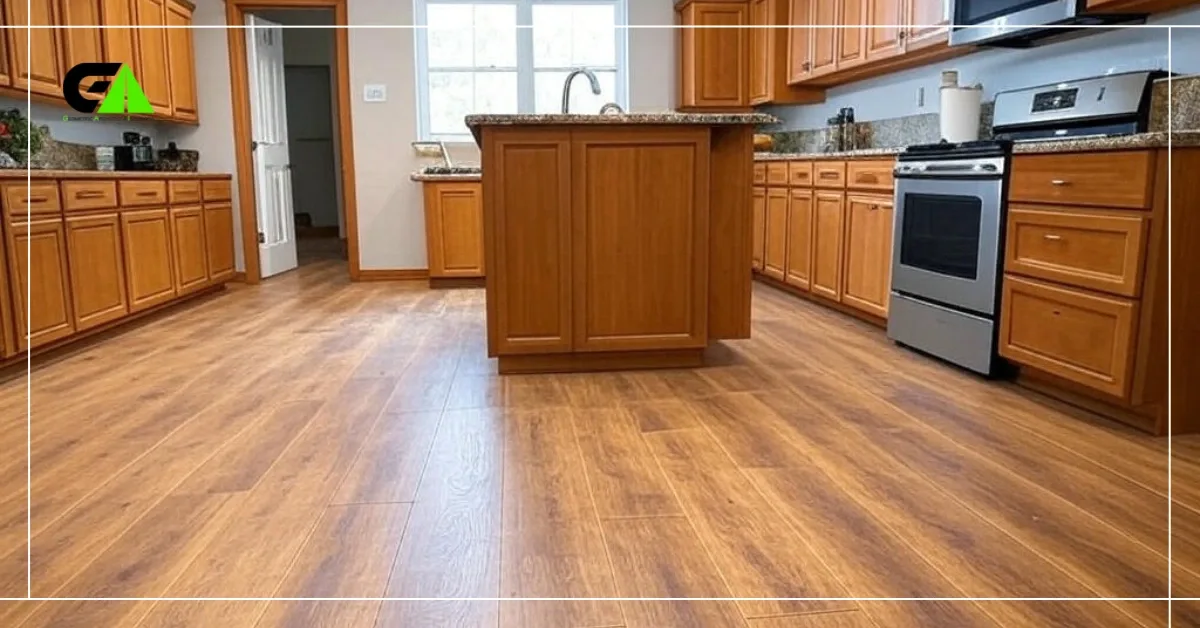
Natural Stone Flooring
Natural stone flooring offers a timeless elegance for kitchen interiors. It is durable, unique, and adds a touch of luxury. This type of flooring is perfect for those who want both functionality and style. Below, we’ll explore two popular natural stone options: Marble and Granite.
Marble
Marble flooring is known for its classic beauty and luxurious appeal. Each marble slab is unique, featuring intricate veins and patterns. This makes marble a stunning choice for kitchen interiors.
Here are some benefits of marble flooring:
-
Timeless elegance: Marble never goes out of style.
-
Unique appearance: Each piece has a distinct pattern.
-
Durable: It can last for many years with proper care.
-
Cool surface: Ideal for warm climates.
Despite its beauty, marble requires regular maintenance. It is prone to staining and scratching, so sealing is essential. Consider these factors when choosing marble for your kitchen.
Granite
Granite flooring is another excellent option for kitchens. It is extremely durable and resistant to wear and tear. Granite comes in a variety of colors and patterns, making it versatile for different design themes.
Advantages of granite flooring include:
-
Durability: Granite is one of the hardest natural stones.
-
Scratch-resistant: Perfect for high-traffic areas.
-
Heat-resistant: Ideal for kitchen environments.
-
Low maintenance: Easier to clean than marble.
Granite may be less prone to damage than marble, but it still requires proper sealing to prevent stains. Its strength and beauty make granite a top choice for kitchen flooring.
|
Feature |
Marble |
Granite |
|---|---|---|
|
Durability |
High (needs care) |
Very High |
|
Maintenance |
Regular sealing needed |
Less frequent sealing |
|
Heat Resistance |
Moderate |
High |
|
Appearance |
Unique patterns |
Varied colors |
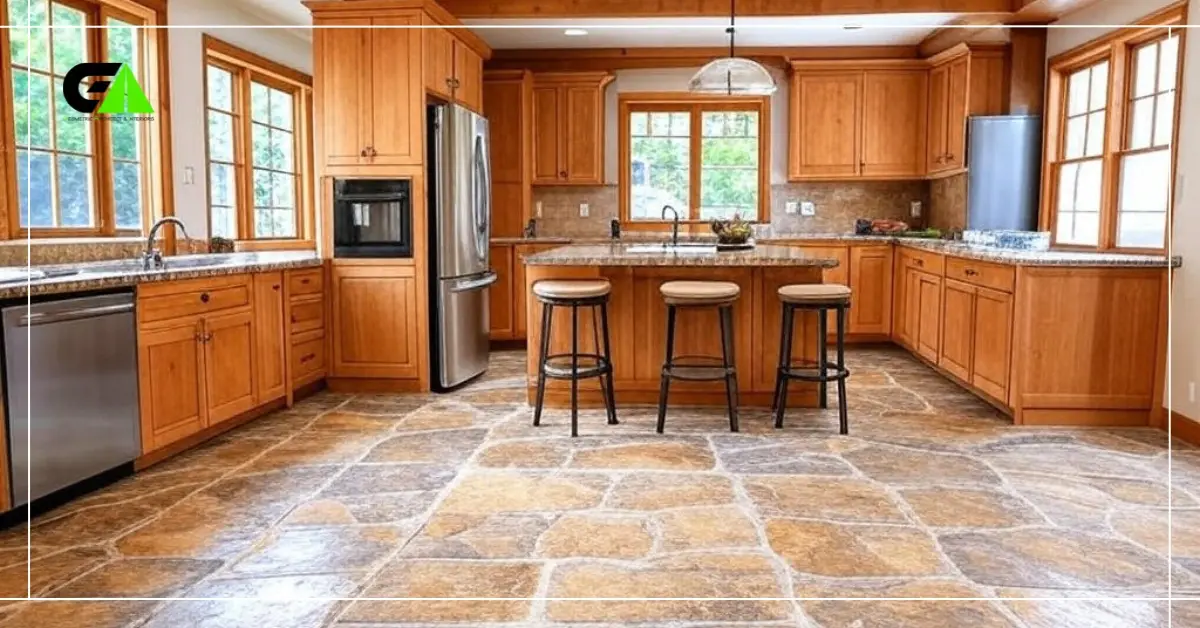
Cork Flooring
Cork flooring is an eco-friendly option for kitchen interiors. It offers a unique look and numerous benefits. This section explores the advantages of cork flooring for your kitchen.
Sustainability
Cork flooring is a sustainable choice for your kitchen. Cork is harvested from the bark of the cork oak tree. This process does not harm the tree, and the bark regrows. This makes cork a renewable resource.
Choosing cork flooring supports the environment. It helps reduce deforestation and promotes biodiversity. Additionally, cork flooring is biodegradable and recyclable. This means less waste in landfills.
|
Benefits |
Details |
|---|---|
|
Renewable |
Harvested without harming trees |
|
Biodegradable |
Decomposes naturally |
|
Recyclable |
Can be reused or recycled |
Comfort
Cork flooring is soft and comfortable underfoot. This makes it ideal for kitchens, where you spend a lot of time standing. The natural cushion of cork reduces stress on your feet and legs.
Additionally, cork flooring provides insulation. It keeps your kitchen warm in winter and cool in summer. The insulation also helps reduce noise. This creates a quieter and more peaceful kitchen environment.
-
Soft and cushiony
-
Reduces foot and leg fatigue
-
Insulates against temperature changes
-
Reduces noise
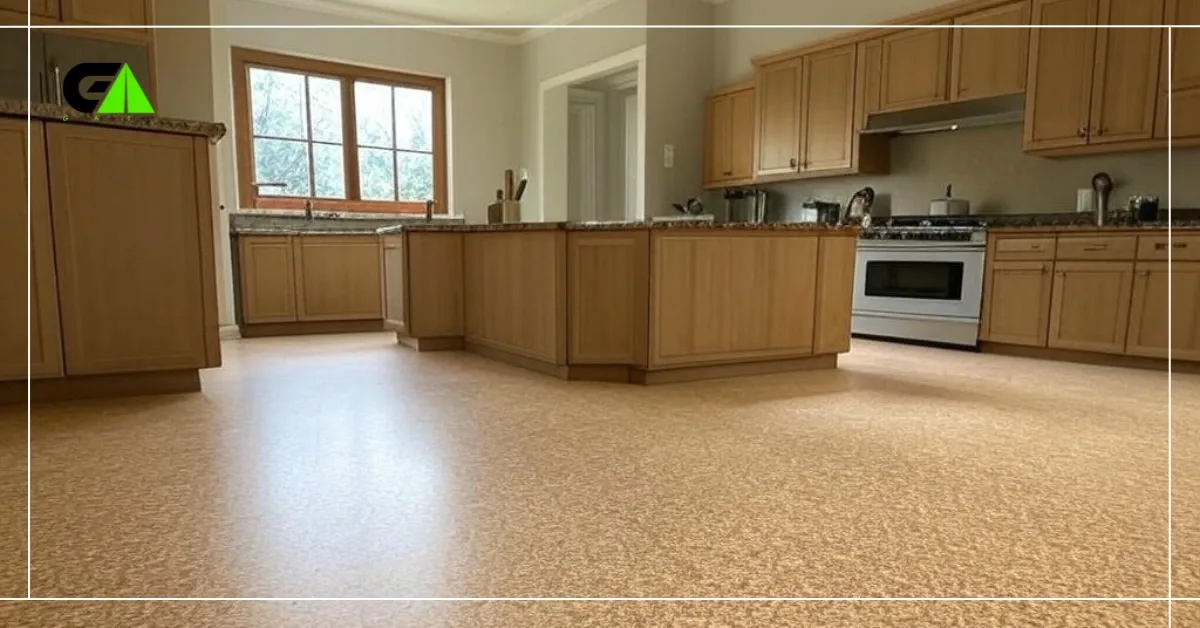
Bamboo Flooring
Bamboo flooring stands out as a modern and stylish option for kitchen interiors. It offers a unique blend of beauty and sustainability, making it a favorite among homeowners. Bamboo is a renewable resource, harvested from fast-growing plants. This makes it an eco-friendly choice that doesn’t compromise on aesthetics.
Eco-friendly Choice
Choosing bamboo flooring means supporting sustainable living. Bamboo plants grow rapidly, often reaching maturity in just five years. This rapid growth rate ensures a steady supply without depleting natural resources. Many bamboo flooring options come from responsibly managed forests. This ensures that the environmental impact remains low.
Durability
Bamboo flooring is surprisingly durable. It can withstand the daily wear and tear of a busy kitchen. High-quality bamboo is harder than many traditional hardwoods. This makes it resistant to scratches and dents. Additionally, bamboo flooring can handle moisture better than some other wood options. This helps prevent warping and damage in kitchens.
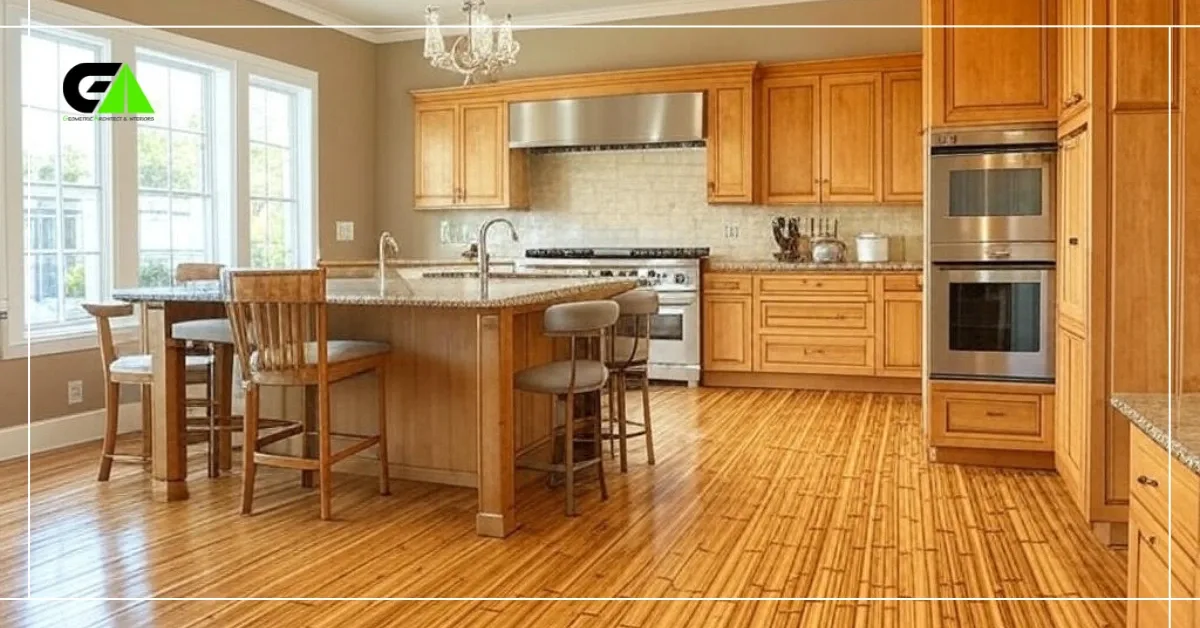
Concrete Flooring
Concrete flooring is becoming a popular choice for kitchen interiors. It offers durability, versatility, and a modern look. Whether you choose stained or polished concrete, each has unique benefits. Below, we explore two concrete flooring options to help you decide.
Stained Concrete
Stained concrete provides a rich, textured look. It allows for a range of colors and patterns. You can achieve a variety of aesthetic styles with this method.
- Versatility: Stains can mimic other materials like wood or marble.
- Durability: Stains penetrate the concrete for long-lasting color.
- Maintenance: Easy to clean and maintain with regular sweeping and mopping.
Stained concrete can also be customized. You can choose different shades and designs to match your kitchen decor. This flexibility makes it an attractive option for many homeowners.
Polished Concrete
Polished concrete is another excellent choice for kitchen floors. It provides a sleek, glossy finish that enhances any kitchen.
- Shiny Finish: Polishing gives the concrete a high-gloss look.
- Low Maintenance: Resistant to stains and spills, making it easy to clean.
- Durable: Extremely durable and can withstand heavy foot traffic.
Polished concrete also reflects light, making your kitchen appear brighter. This flooring option is ideal for those seeking a modern, clean look.
Whether you choose stained or polished, concrete flooring offers a stylish and practical solution for your kitchen. Both options provide durability and low maintenance, making them perfect for busy households.
You may like it: Different Types Of Kitchen Layouts
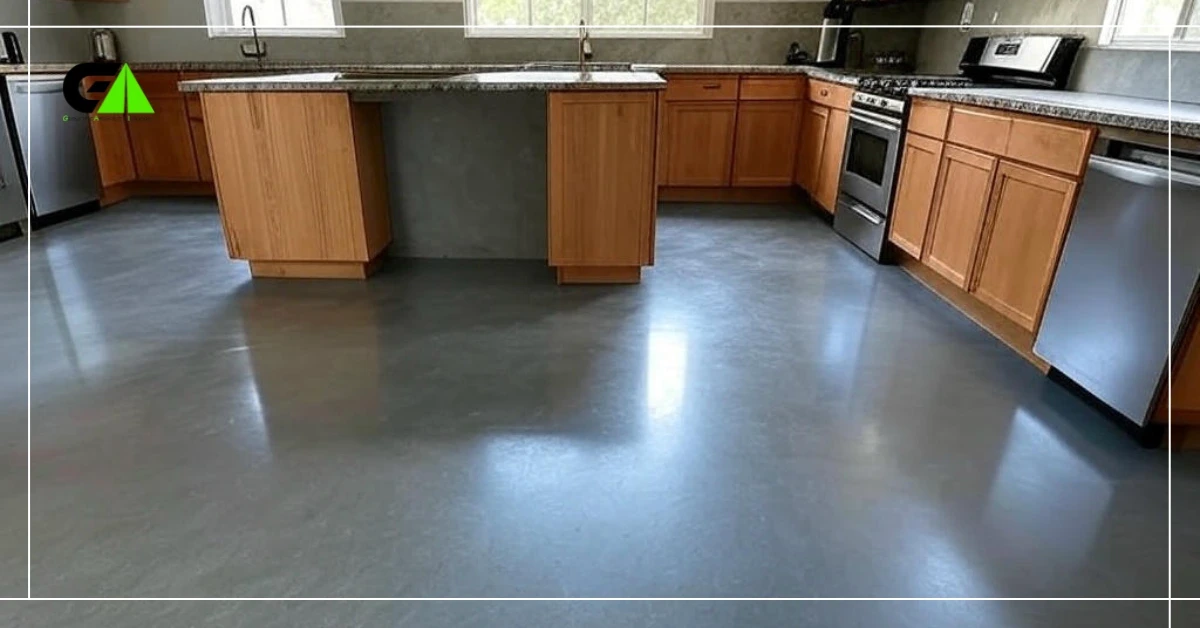
Frequently Asked Questions
What Is The Best Flooring For Kitchens?
The best flooring for kitchens is durable and water-resistant. Options include ceramic tiles, vinyl, and hardwood. These materials offer longevity and easy maintenance.
Is Hardwood Flooring Suitable For Kitchens?
Yes, hardwood flooring is suitable for kitchens. It adds warmth and elegance. Ensure it is sealed properly to prevent water damage.
Are Ceramic Tiles Good For Kitchen Floors?
Yes, ceramic tiles are excellent for kitchen floors. They are durable, water-resistant, and come in various designs. They are also easy to clean.
What Are The Benefits Of Vinyl Flooring In Kitchens?
Vinyl flooring is cost-effective, water-resistant, and easy to install. It offers diverse styles and requires low maintenance. It’s a practical choice.
Conclusion
Choosing the right kitchen flooring can change your space. Each option has its benefits. Tiles offer durability. Hardwood brings warmth. Vinyl is budget-friendly. Think about your needs and lifestyle. Pick what fits your style. Your kitchen deserves the best look and function.
Happy decorating!

